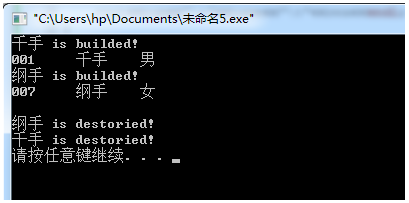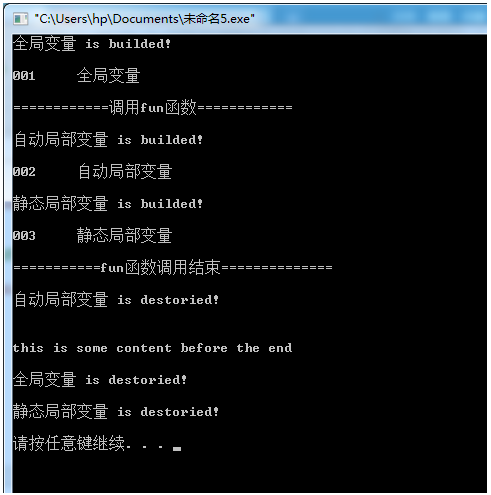構造函數:
在類實例化對象時自動執行,對類中的數據進行初始化。構造函數可以從載,可以有多個,但是只能有一個缺省構造函數。
析構函數:
在撤銷對象占用的內存之前,進行一些操作的函數。析構函數不能被重載,只能有一個。
調用構造函數和析構函數的順序:
先構造的後析構,後構造的先折構。它相當於一個棧,先進後出。
代碼如下:
#include<iostream>
#include<string>
using namespace std;
class Student{
public:
Student(string,string,string);
~Student();
void show();
private:
string num;
string name;
string sex;
};
Student::Student(string nu,string na,string s){
num=nu;
name=na;
sex=s;
cout<<name<<" is builded!"<<endl;
}
void Student::show(){
cout<<num<<"\t"<<name<<"\t"<<sex<<endl;
}
Student::~Student(){
cout<<name<<" is destoried!"<<endl;
}
int main(){
Student s1("001","千手","男");
s1.show();
Student s2("007","綱手","女");
s2.show();
cout<<"nihao"<<endl;
cout<<endl;
cout<<"NIHAO"<<endl;
return 0;
}

先構造的千手,結果後析構的千手;後構造的綱手,結果先折構的綱手。
特點:
在全局范圍定義的對象和在函數中定義的靜態(static)局部對象,只在main函數結束或者調用exit函數結束程序時,才調用析構函數。
如果是在函數中定義的對象,在建立對象時調用其構造函數,在函數調用結束、對象釋放時先調用析構函數。
代碼如下:
#include<iostream>
#include<string>
using namespace std;
class Student{
public:
Student(string,string);
~Student();
void show();
string num;
string name;
};
Student::Student(string nu,string na){
num=nu;
name=na;
cout<<name<<" is builded!"<<endl<<endl;
}
void Student::show(){
cout<<num<<"\t"<<name<<endl<<endl;
}
Student::~Student(){
cout<<name<<" is destoried!"<<endl<<endl;
}
void fun(){
cout<<"============調用fun函數============"<<endl<<endl;
Student s2("002","自動局部變量");//定義自動局部對象
s2.show();
static Student s3("003","靜態局部變量");//定義靜態局部變量
s3.show();
cout<<"===========fun函數調用結束=============="<<endl<<endl;
}
int main(){
Student s1("001","全局變量");
s1.show();
fun();
cout<<"\nthis is some content before the end\n";//這是一段位於main函數結束之前,函數調用之後的內容
cout<<endl;
return 0;
}
